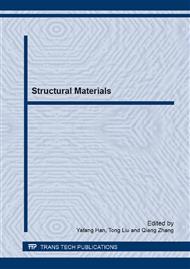p.357
p.362
p.367
p.372
p.378
p.384
p.390
p.396
p.406
Effects of Cooling Processes on Microstructure Evolution of X80 Pipeline Steel
Abstract:
With the development of pipeline industry, the pipeline steels with higher strength and plasticity, better low-temperature toughness and weldability are the main development trend. For bainitic pipeline steels, M/A constituent is the main hard phase. Although the M/A constituent can enhance the strength, the larger block-form M/A constituent can deteriorate low-temperature toughness. Therefore, it is essential to further investigate how to refine the M/A constituent. In the present paper, X80 pipeline steel was cooled to room temperature with various cooling paths after hot compression deformation at the temperature of 800oC. The evolution of microstructure of X80 pipeline steel has been analyzed by optical microscope (OM) and scanning electron microscope (SEM). The experimental results show that increasing the cooling rate can significantly refine M/A constituent and promote the formation of granular bainite, and the bainitic ferrite can be also greatly refined. In addition, the effects of five final temperatures of fast cooling were also investigated.
Info:
Periodical:
Pages:
378-383
Citation:
Online since:
April 2014
Authors:
Keywords:
Price:
Сopyright:
© 2014 Trans Tech Publications Ltd. All Rights Reserved
Share:
Citation:


